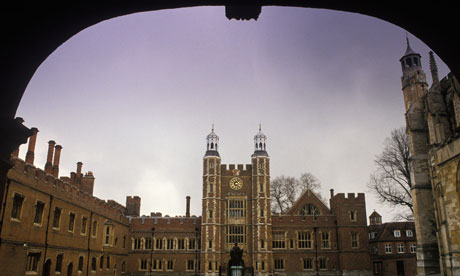More than 62,000 teachers at independent schools enjoy more cash when they retire, costing taxpayers millions
Jessica Shepherd, education correspondent
The Guardian, Saturday 6 November 2010
 Eton school, which saves money by being allowed to access the Teachers’ Pension Scheme. Photograph: Alamy
Eton school, which saves money by being allowed to access the Teachers’ Pension Scheme. Photograph: Alamy
Millions of pounds of public money is being spent subsidising the pensions of teachers at England’s most expensive public schools, including Eton and Harrow, the Guardian reveals today. More than 62,000 teachers at independent schools, including more than 1,600 at the country’s top public schools, are enjoying the same pensions, underwritten by the government, as teachers working in state schools, data disclosed under the Freedom of Information Act shows.
Private school and state school teachers alike are eligible for the security and generous conditions of the Teachers’ Pension Scheme, it has emerged. Teachers under the scheme contribute 6.4% of their salary to their pension, while their employer contributes 14.1% of their salary. Critics say that if private sector employers wanted to match the benefits of this scheme, they would have to contribute at least 20% of their employees’ salaries. This means the government is in effect subsidising private schools‘ contributions by at least 6%.
Currently, teachers can retire between the ages of 60 and 65. It is widely thought that contributions from a teacher and their employer under this scheme do not cover the eventual cost of paying pensions to retired teachers, and the government has to underwrite this cost. Lord Hutton is currently carrying out an independent review of public service pension schemes.
The Green party, which requested the data, has calculated that the government is paying millions of pounds into private schoolteachers’ pensions by allowing them to be part of the scheme. The average wage for an independent school teacher is about £35,000. If the government guarantees 6% of the pension contributions of a teacher and there are 62,349 independent school teachers in the scheme, this amounts to more than £131m. The Department for Education, which responded to the request for information, said 1,639 of the 62,349 private school teachers in the scheme worked at top public schools such as St Paul’s, Harrow and Eton.
Private sector companies usually have to fund their own pension schemes, which are not underwritten by the government and tend to be subject to the fluctuations of the stock market. Private sector employers usually contribute at least 20% of an employee’s wages into their pension. The Teachers’ Pension Scheme is a final salary scheme which guarantees a teacher a fixed-sum pension until they die and comes with benefits for their family and dependents. The private school teachers in the scheme do not have and there is no requirement to have worked in state schools during their careers.
Noel Lynch, chair of the London Green party, said it was scandalous that taxpayers were contributing to the pensions of teachers at Eton and Harrow.
“Yet again, ordinary people are effectively subsidising the fees of these elite institutions,” he said. “If we really are ‘all in this together’, then private schools should be charged the true cost of these pensions and taxpayers’ cash should be redirected towards more urgent and appropriate spending within the education budget.” He added that if private schools were able to offer the same pensions as state schools, it was easier for them to attract the best staff from state schools.
The amount teachers receive depends on whether they joined the profession before the end of 2006 and for how long they have worked.
Teachers who joined the profession before the end of 2006 have their salary divided into 80ths. If they have worked for 40 years when they retire, they receive 40 80ths – or 50%. If they have worked for 20 years, they receive 20 80ths. If they have worked for 40 years, they also receive a lump sum worth 1.5 times their final salary.
Teachers who joined the profession after the end of 2006 have their salary divided into 60ths. If they have worked for 40 years, they receive 40 60ths. But they do not get a lump sum on top of this.
A spokesman for the Department for Education said access to the scheme allowed teachers to move “more easily” between the private and state sectors.
“For a number of years, like many other public sector schemes, the government has, under limited circumstances, allowed private sector employers such as independent schools to access the Teachers’ Pension Scheme. They receive no special dispensation within the scheme and must meet the same employer contributions [14.1%] as other employers. In addition, teachers contribute 6.4% of their salary to meet the costs of the scheme.
“Many teachers move between the independent and state sectors during their working lives, so access to the TPS for all schools allows teachers to move more easily between the sectors, which helps benefit the education system for all.”
David Lyscom, chief executive of the Independent Schools Council, said “pension transferability” could play a “key role in promoting mobility”. “Teachers and their schools in the independent sector have always contributed in full to the pension scheme, at levels required by the government of the day.”
The private school teachers in the scheme do not have to have worked in state schools during their careers.
Source: guardian.co.uk
Tags: England, Eton, Harrow, pensions, public schools, teachers
 Oxstones Investment Club™
Oxstones Investment Club™